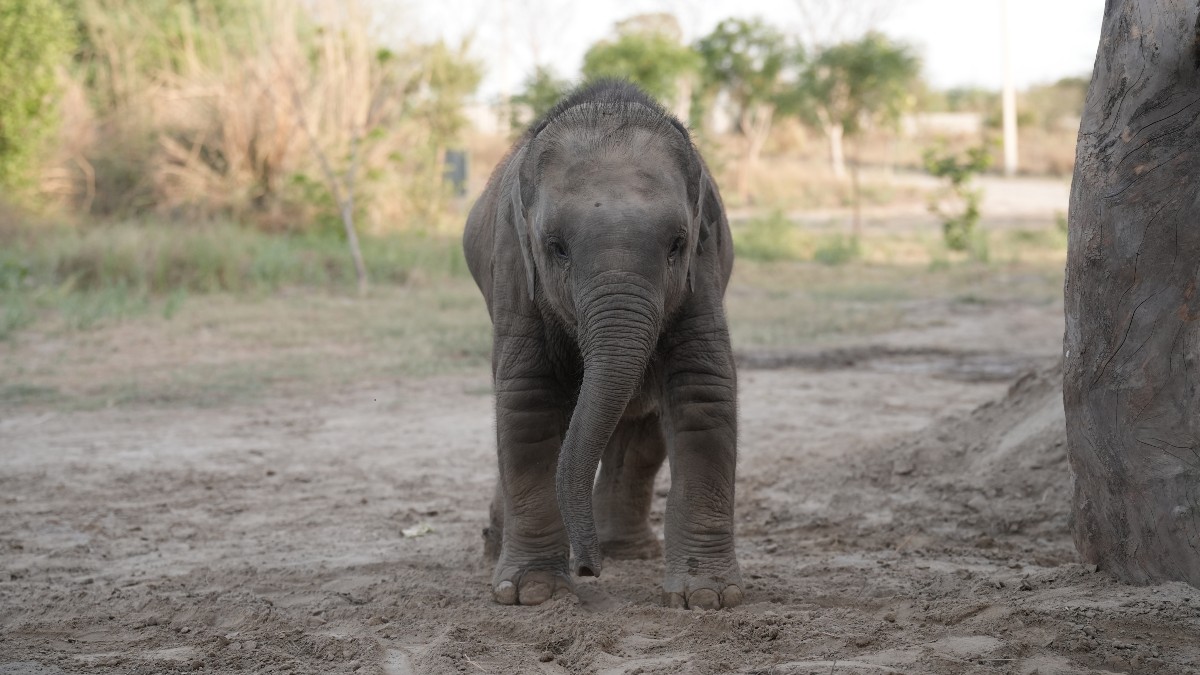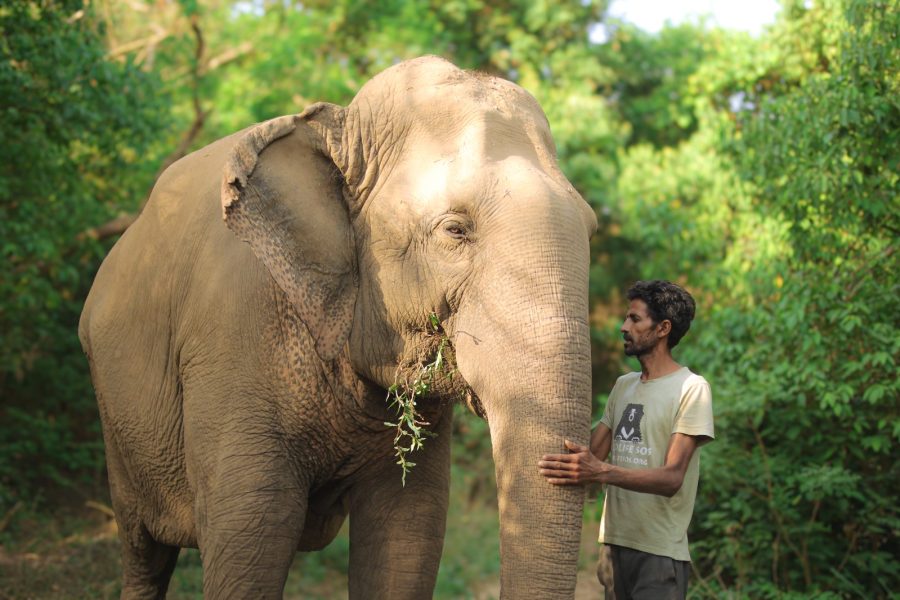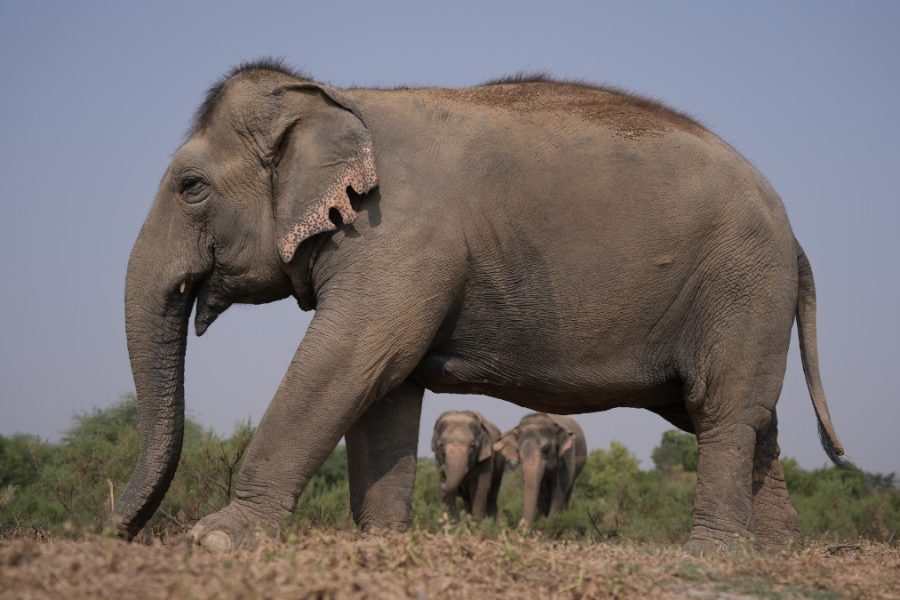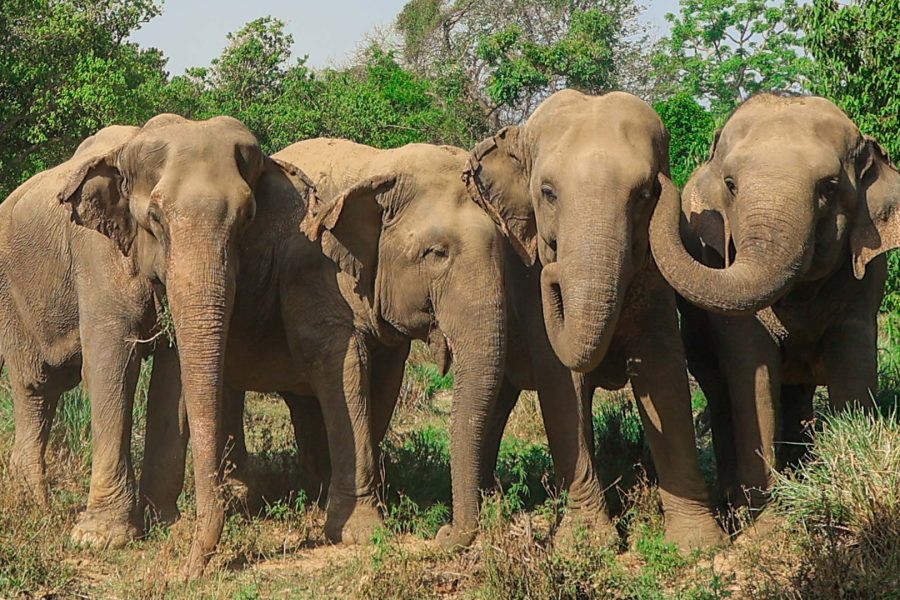After over a decade of rescuing and rehabilitating elephants who have been victims of various forms of abuse, Wildlife SOS now houses its very first elephant calf. Though she is not a direct victim of human imposed abuse, her unfortunate situation is man-made. Rescued after a tragic train collision that killed her adult female companion, Bani was left without the support of a family, and with no sensation in her hindlimbs. This battered and lonely calf, not yet a year old back then, was brought under our care so that our dedicated team of veterinarian and caregivers could work their magic through intensive treatment and therapies to help her survive and regain the ability to walk.
Hope was sparse and only shared in hushed whispers when our team first saw Bani, but despite our fears, a miracle is exactly what our team managed to achieve. Not only has Bani survived, but she has also regained some mobility in her hindlimbs. While her physical condition requires a long healing journey, Bani, in the four months of adaptive treatment and care, has been responding to the attentive care given to her. From days when she could barely move and required external support to lift her up, the infant can now stand and walk for nearly 20 hours. Although she still drags her hind legs while doing so, it truly reflects remarkable improvement in this resilient calf.
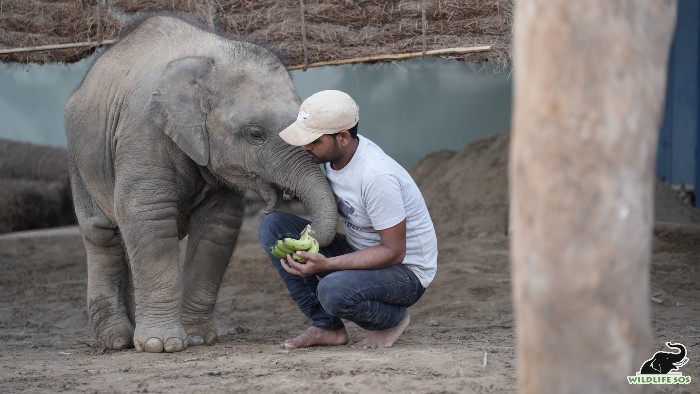
To achieve such an incredible feat, our team of veterinarians conducted extensive research on various techniques and technologies to support her medically. Additionally, as this was the first time we were taking care of an injured baby calf, the medical team delved into comprehensive studies on caring for elephant infants. Numerous experts across various medical fields and countries were consulted to determine the appropriate approaches for her care and treatment.
Bani’s injury to her hindlimbs was trauma-induced, causing her to be recumbent for a while before Wildlife SOS’s medical team intervened. It was imperative to get her on her feet as soon as possible, as prolonged recumbency can lead to issues like high organ pressure and poor blood circulation. The paralysis in her hindlimbs could result in stiffness and muscle loss if not kept active and pliable. Therefore, in addition to the usual supplements, neuro-tonics, and ortho-medications provided to her, Bani also received various physiotherapy treatments.
This article highlights some of the therapies that have been used and continue to be in use as part of Bani’s healing journey at the Elephant Hospital Campus (EHC).
Physiotherapy
Various physiotherapies are being carried out to help Bani, but before we delve into each, it’s important to understand what exactly it entails. Physiotherapy, or physical therapy, is a treatment method aimed at restoring, maintaining, and maximising a patient’s mobility, function, and well-being following a disease, injury, or deformity. This is achieved through methods such as massages, heat treatments, and exercises, supplementing medical drugs or surgery if in case these are required. These treatments utilise different forms of energy, including light, sound, heat, and electricity, to activate the cells on a molecular or cellular level to induce healing. Not only do these therapies improve muscle function, but they also play a significant role in pain management. The following are the therapies used on Bani since she came under our care:
- Laser therapy
L.A.S.E.R. stands for Light Amplification by Stimulated Emission of Radiation. It uses low-intensity laser light to relieve pain and promote cell regeneration after soft tissue damage. Due to the accident, Bani had numerous abrasion wounds and bed sores scattered on her body from prolonged recumbency. To expedite the healing of these wounds and alleviate her pain, laser therapy was conducted directly on the affected areas, with special attention given to her hindlimbs.
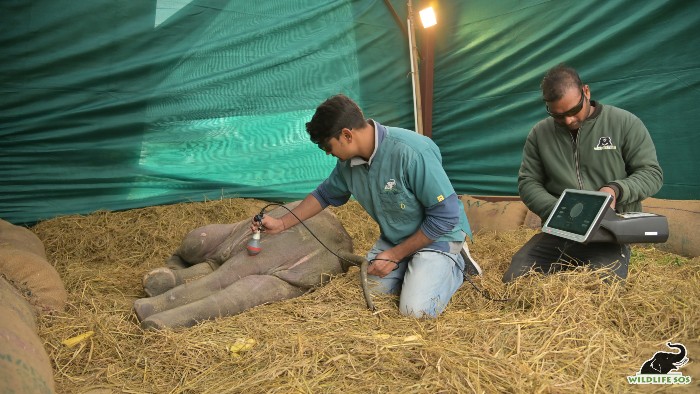
Low-level laser therapy stimulates the mitochondria in the cells by providing extra energy to increase their ATP (Adenosine triphosphate) production. This boost in cellular activity enhances tissue regeneration through the release of nitric oxide and endorphins, which help reduce pain, swelling, and inflammation. Additionally, it aids in muscle relaxation. Laser therapy also accelerates tissue repair, improves vascular activity, and increases metabolic activity.
- Infrared light therapy
Another therapy used to help Bani manage joint and muscle pain in her hind legs is infrared radiation therapy, also known as light therapy. This treatment employs light with wavelengths between 700 and 1,000 nm, which are proven to be highly effective in reducing inflammation and alleviating pain. The light penetrates up to 7 cm deep into the skin, reaching muscles, nerves, and bones, making it one of the most effective therapies for treating inflammatory conditions. It also helps in pain relief, reduction of muscle tension, relaxation, improved circulation, and a boosted immune system.
- Therapeutic ultrasound
Therapeutic ultrasound is a treatment commonly used in physical therapy to provide deep heating to soft tissues, enhancing the healing process for muscles, tendons, joints, and ligaments by increasing blood flow. Additionally, it is effective in softening scar tissue. Unlike diagnostic ultrasound, which generates imaging to assess medical conditions, therapeutic ultrasound uses sound waves to create heat and movement in body tissues, aiding in the treatment of injured areas.
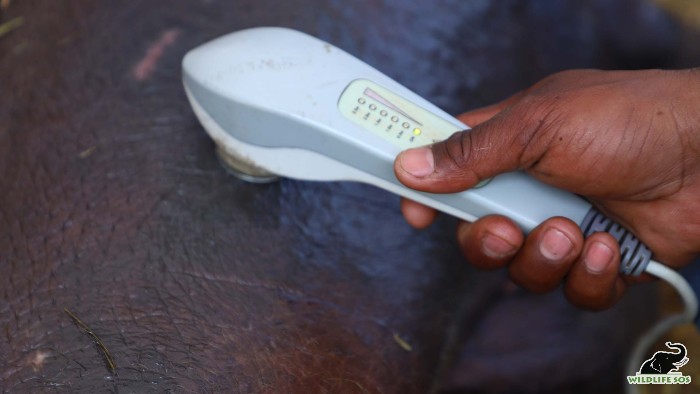
Therapeutic ultrasound operates at frequencies between 0.75 and 3 MHz, with most machines set at either 1 or 3 MHz. Low-frequency ultrasound waves penetrate deeper but are less focused. Therefore, 1-MHz continuous ultrasound, with a half-value depth of approximately 2.3 cm, is used to treat deeper tissues, around 2.3 to 5 cm deep. In contrast, 3-MHz ultrasound, with a smaller half-value depth, is used to heat more superficial tissues, from 0.8 to 1.6 cm deep.
- Electric muscle stimulation (EMS)
Electrical muscle stimulation (EMS) is a type of electrotherapy that uses electrical impulses to instigate muscle contractions. This therapy strengthens weak muscles, reduces swelling, relieves pain, improves blood circulation, and aids in wound healing. Clinical studies have shown that electrical stimulation enhances axon growth during nerve repair and accelerates sensorimotor recovery. During EMS, electrodes are attached to areas of the affected body parts, and small electrical impulses are sent through the muscles. This harmless and painless method acts as a light workout that exercises Bani’s muscles.
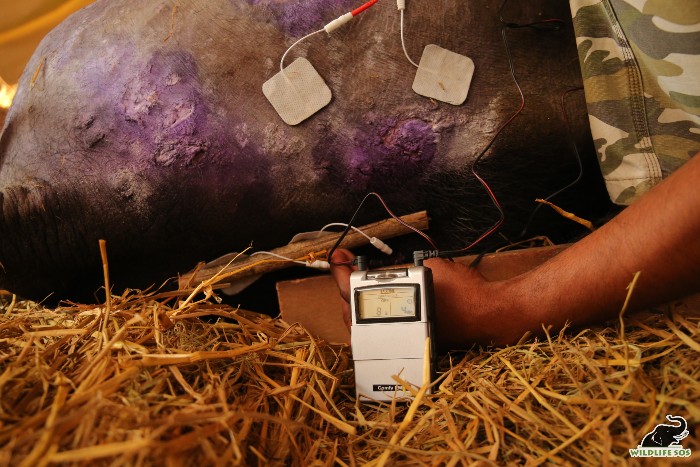
Since Bani’s hip girdle injuries were not detectable using X-rays, EMS was introduced to help jumpstart the paralysed muscles and nerves in her hindlimbs. The goal was to provide enough stimulation to prevent muscle atrophy.
- Ayurvedic Oil Massage
To provide Bani with comprehensive treatment and enhance her chances of survival, our team enlisted the expertise of a skilled Panchakarma Ayurvedic practitioner. This practitioner travelled from Kerala to Mathura to share his knowledge with our veterinarians and caregivers, teaching them the most effective techniques in Ayurvedic hot oil massage.
Ayurveda, a natural system of medicine originating in India over 3,000 years ago, is based on the principle that disease is caused by an imbalance or stress in a person’s consciousness. The massage is done by applying warm oil to the entire body, from the scalp to the soles of the feet. For Bani, a lot of the massage was concentrated on her hindlimbs.
The two oils used during her sessions were Murivenna and Valiya Sahacharadi Tailam. Murivenna, prepared with a coconut oil base, is a renowned remedy for pain and sprains. It is effective for fresh wounds and ulcers, promoting quick healing and relieving inflammation and pain in fractures, and non-healing ulcers. Valiya Sahacharadi Tailam, enriched with the herb sahachara, provides significant relief from lower backache, sciatica, numbness, tingling sensations, and joint pain. It also helps control involuntary body movements like tremors and tics.
- Hydrotherapy Sessions
Once Bani began standing for longer periods with the help of crane-assisted slings, it was time for her to start practising walking on her own and have confidence in doing so. To facilitate this and prevent further injury, our team of veterinarians introduced her to the hydrotherapy pool. Here, she could exercise her legs safely, minimising the risk of injury if she stumbled or fell. A team of 6–7 caregivers and veterinarians was always on standby to assist her in case of any mishaps.
Hydrotherapy uses water to treat various symptoms throughout the body. One of its most significant benefits is the buoyancy of water, which reduces weight-bearing stress on her hindlimbs and encourages freedom of movement and range of motion. The aim of hydrotherapy is to relax muscles, improve joint range of motion and muscle strength, and reduce pain in a safe and enjoyable environment. The water supports the body’s weight, increasing joint movement, and providing resistance for strengthening exercises.
Homoeopathic Treatment
In a determined effort to revive baby Bani’s health, our veterinarians turned to homoeopathic medicine as a complementary treatment alongside conventional allopathic care. This decision was made after thorough consultation with registered homoeopathic practitioners. Homeopathy, a field that began its scientific development in the 19th century under the German physician Dr. Samuel Hahnemann, operates on the principle of “similia” or “let likes be cured by likes”. This principle suggests that substances that produce symptoms of a disease in healthy individuals can stimulate the body’s healing response when administered in diluted form. Homoeopathic medicines are derived from a variety of sources including plants, animals, and synthetics, and are meticulously diluted using alcohol or distilled water to boost their therapeutic properties.
Some of the homoeopathic medications provided to Bani included Causticum, used for chronic diseases, rheumatic pain, arthritis, and muscle weakness; Arnica Montana for post-injury bruises and muscular cramps; Hypericum for lacerated wounds and nerve-rich area injuries; and Rhus Toxicodendron for itchy skin, herpes, eczema, and rheumatic pains.
Acupuncture
As Bani’s condition improved and she began standing and walking for longer periods of time, our veterinarians shifted their focus from merely keeping her on her feet to restoring proper motor functions in her paralysed hindlimbs. To achieve this, they incorporated another traditional medicinal therapy: acupuncture. Originating in China around 3,000 years ago, the practice of acupuncture is contemporaneous with Ayurveda in India.
Acupuncture is based on the belief that the body contains numerous acupuncture points interconnected by various meridians through which life energy, or qi, flows. Activating these points is thought to improve the flow of blocked or stagnant qi. By unblocking these energy pathways, acupuncture facilitates faster healing.
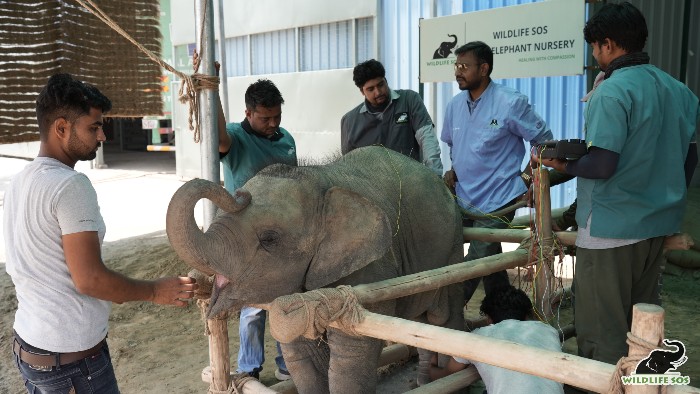
Additionally, acupuncture is more effective when combined with traditional physiotherapy techniques. While acupuncture reduces physical tension and trigger points and calms the nervous system, physiotherapy helps to strengthen and restore healthy movement patterns. Acupuncture points are believed to nudge the central nervous system to respond, releasing chemicals like endorphins, norepinephrine, and enkephalin into the muscles, spinal cord, and brain. These biochemical changes may increase the body’s natural healing abilities, and promote physical and emotional well-being.
Two types of acupuncture therapies have aided Bani:
- Laser acupuncture
Defined as the stimulation of traditional acupuncture points with low-intensity, non-thermal laser irradiation, laser acupuncture is a non-invasive technique that uses low-level laser beams instead of traditional needles. It helps reduce pain, improves circulation, and promotes tissue healing by activating the body’s natural energy pathways.
- Electroacupuncture
This technique involves attaching electrodes to acupuncture needles to provide a gentle electrical current, enhancing the stimulation of acupuncture points and promoting better muscle function and nerve regeneration. It is particularly effective for treating paralysis and improving motor functions. Due to the invasive nature of the treatment and the specialised knowledge required, we enlisted the help of an acupuncture specialist from Thailand, who travelled to the centre to teach our team of veterinarians the process of electroacupuncture, and contributed towards improving Bani’s condition.
Bani’s treatment plan is continually evolving based on her reactions and progress. Our skilled team of veterinarians and caregivers is committed to leaving no stone unturned in providing Bani with the best possible care and round-the-clock attention. While every small muscle twitch in her hindlimb is a cause for celebration, every dragging step she takes serves as a constant reminder of the long journey ahead.
You can be an integral part of baby Bani’s healing by sponsoring her treatments. Your support will make a significant difference in ensuring she receives the essential care she needs. We thank each and everyone of you for cheering for our little fighter, Bani.

